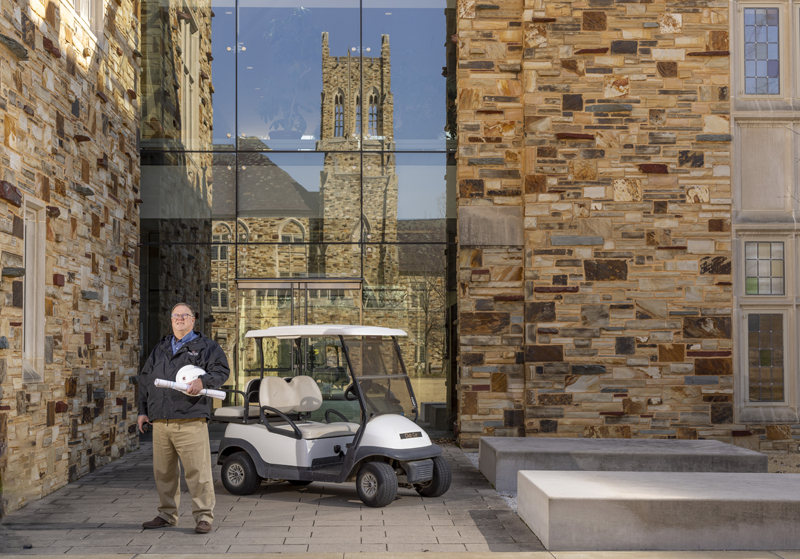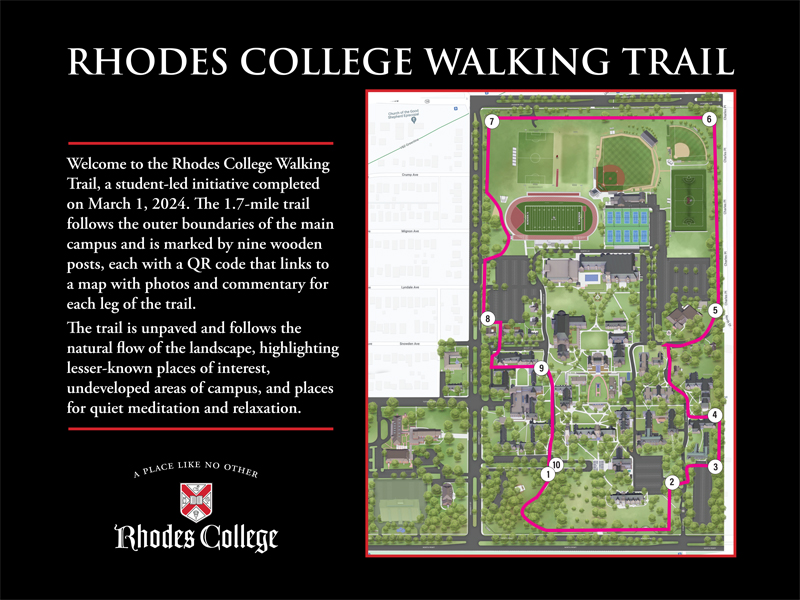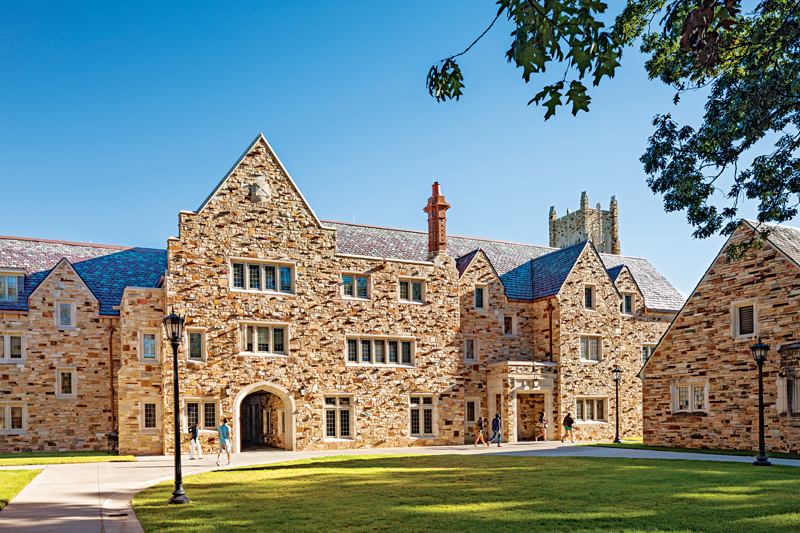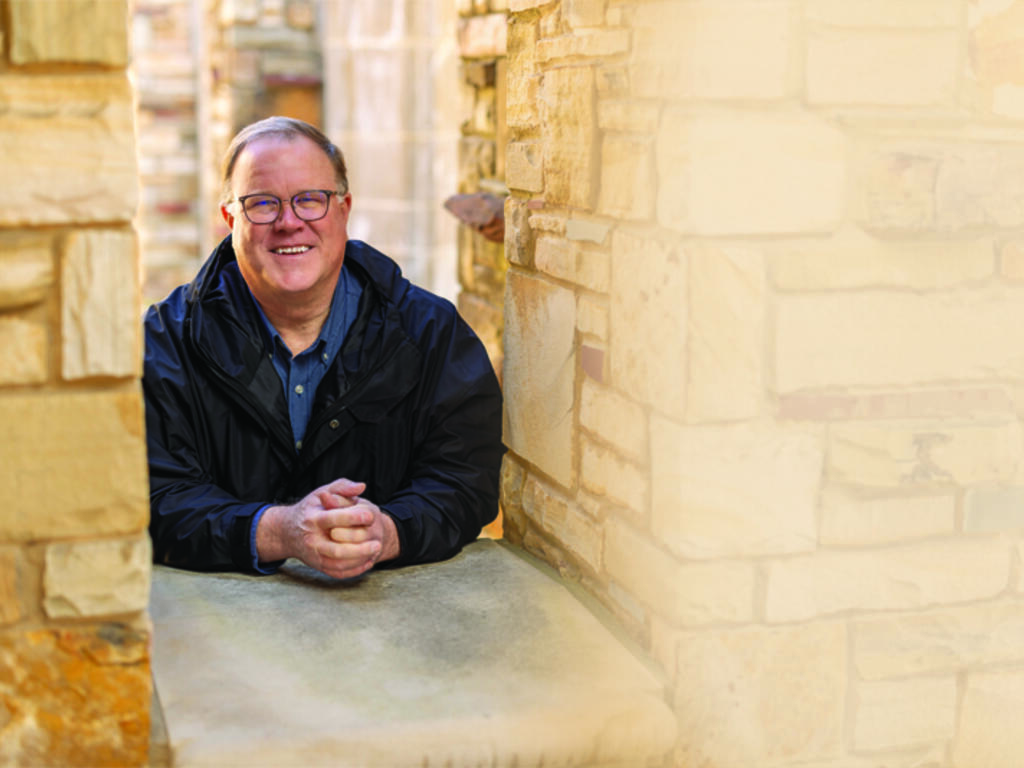Students and faculty see plenty of recognizable names as they stroll through the beautiful Rhodes College campus. Every day, there are the Barrets, the Burrows, the Buckmans, and plenty of others. But one name that they might not be as familiar with is Brian Foshee P’16, the longtime director of physical plant who spent the better part of four decades making Rhodes look its pristine and welcoming self each day. But flying under the radar, and letting the 123-acre campus’ Collegiate Gothic architecture do the talking, is just how Foshee prefers it.
“I was at Rhodes 37 years,” says Foshee, “and I’ve been blessed to do what I love in life.” Foshee first made his mark on Memphis away from Rhodes, working on a number of recognizable institutions as a project manager for the City of Memphis. One of his favorites was the Ramesses II exhibition as part of Wonders: The Memphis International Culture Series at the old Cook Convention Center. The major Orpheum Theatre renovation in 1982 is another notable example.
As Rhodes’ director of physical plant, Foshee’s responsibilities included planning, design, construction, and building maintenance. “Campus has expanded a lot,” he says. “So it became about curating this larger space while keeping the quality at the same level. We made some positive changes: We added some great new buildings, and we turned Rhodes into a core pedestrian campus by moving parking to the perimeter.”
Foshee’s first exposure to Rhodes came long before his professional career. Growing up in Memphis, he ran track during his high school years, and one annual meet saw him lace up on what is now the Winston Wolfe Track at Crain Field. Were the seeds planted then for a long and fruitful Lynx career? The campus certainly piqued his interest. “At that time I was really only familiar with Mallory Gym, but just kind of walking through I thought it was one of the most beautiful campuses I’d seen.”

So when the call came to take a position at Rhodes College in 1987, the choice was simple. A few years earlier, the Board of Trustees had adopted a resolution that the college would not deviate from its Collegiate Gothic design, and he relished the idea of building new creations that could seamlessly fit in on campus. “Most of our visitors, especially prospective students, the first thing they talk about is the beauty of the buildings,” says Foshee. “If someone said ‘Let’s change the style, and not have that beautiful sandstone slate, or get rid of the stained glass,’ it would be a very different place.”
While Rhodes already boasted a picturesque aesthetic when Foshee arrived, many of the structures that students enjoy today are thanks to Foshee’s guiding hand. He recalls his first big assignment in 1989: the renovation of Stewart Hall. “Stewart was originally a boarding hall back in the ’40s,” says Foshee. “The college acquired it and converted it to residential. And in 1989, we basically rebuilt the restrooms and stairwells of that building and then did an internal facelift. Fast forward a decade, and we completely gutted Stewart and rebuilt it! We saved the stairwells, but we completely rebuilt that building with new interiors, new windows, new doors, painted the exterior, put the fence and columns around the perimeter, painted it so that it had more of an earth tone. Even across the street on University, it really meshes with the rest of campus and makes it feel connected.”

Stewart Hall let Foshee cut his teeth on Rhodes’ Gothic designs. But every artist has a magnum opus, and for Foshee it came in the form of the campus’ central crown jewel: the Paul Barret, Jr. Library. At 140,000 square feet, the library became his largest project at Rhodes. Alongside the architectural firm and longtime Rhodes collaborator Hanbury, Foshee navigated the process from conception to construction in a quick five-year period. “For most projects on a university campus, a building of this size will take 10 years to complete,” he says. “But we had funding from the Paul Barret, Jr. Trust during the 1999-2000 school year, and we had a need for this space.”
With a team of expert planners and designers, plus consultation from then-library director Lynne Blair, Barret’s current director Darlene Brooks, and associate director of library services Bill Short ’71, Foshee worked quickly and efficiently to have the library open in 2005. “Lynne, Darlene, and Bill knew exactly what they wanted,” says Foshee. “If you look at the building now and ask them if they’d change anything, I bet they’d say they wouldn’t change a thing.”
When the library opened its doors, Foshee, as is his character, stepped back from the spotlight to let the work shine. He clearly recalls a moment of recollection on opening day, as he watched Lewis Donelson ’38, a prominent attorney and a Rhodes trustee, meet former U.S. Senator Howard Baker, Jr. in the lobby. “They were standing maybe 20 feet from me, and as soon as they walked in the door, their mouths fell open and they said, ‘Wow.’ Lewis said it exceeded his expectations, and I’m just sitting over here jumping for joy, because we got the end result we wanted. There were a lot of great memories in that project, and it’s a place where students can continue to create memories, and that’s really what we’re proud of.”
If the quick turnaround time on projects seems surprising from the outside, that’s not the case for Foshee. “It’s all about assembling a good team, and we’ve accumulated a lot of institutional knowledge on how to approach these,” he says. For Foshee, interrupting the quiet serenity of a calm spring morning with the sound of hammers and drills is a non-starter. During his tenure, most renovations came during a 12-week period during the summer, when campus traffic is at its lowest. “We want to have as little impact on the day-to-day as possible,” he says. “So we became adept at doing projects quickly during the summer break. Then students could come back and be greeted by improved buildings.”

Even within the last decade, there are plenty of examples of Foshee’s work enriching campus: The West Village residence hall, a renovated Catherine Burrow Refectory, and Robertson Hall, to name a few. “I was excited about Robertson,” says Foshee. “It was an opportunity to create a 21st-century science building that incorporated modern flourishes within our Gothic design.” He and Hanbury moved forward with an idea he calls monumental glazing. Robertson’s sweeping two-story windows allow for plenty of natural light, and are mirrored by large limestone panels. Inside, large windows allow for views into classrooms from the hallway, offering students a chance to peek at what their peers are working on in a class or lab.
During his tenure, Foshee has kept a firm focus on maintaining the integrity of the campus design. But he has also made sure that students have had a platform to contribute to that design. If a student has a good idea to improve campus, he says, then he’s all for making it happen. The student-led National Pan-Hellenic Council Plaza [profiled on page 26], just outside the Bryan Campus Life Center, was unveiled to much fanfare earlier this spring.
Another big project that came to fruition last semester was the creation of a new walking trail around the campus perimeter. “I was in a meeting with President Collins and Rhodes Student Government president Claire Kiernan ’24, and she came to us with this idea for a trail. We both thought it was a great concept, so she developed a plan and we got to work.”
Kiernan and Foshee took a golf cart around campus to chart a path. “As soon as I brought up the idea, Brian immediately went, ‘Let’s figure it out,’” says Kiernan. “As a student, it can be terrifying to pitch an idea. But both Brian and President Collins were very supportive, and it’s really gratifying to see that kind of support for a student project.” The walking trail has 10 cedar posts set up around the campus perimeter (planted courtesy of the Rhodes football team), each marked with a QR code that links to a page with nuggets of college trivia.
“There really are so many beautiful hidden parts of campus around the perimeter that go undiscovered,” adds Kiernan. “Brian was really helpful during the process, and even during other projects, such as getting new outdoor furniture around campus. He was a really big advocate of the trail. He saw just how much I wanted to make it happen, and how much it could help the school and benefit students, faculty, staff, and alumni. He became just as passionate about the project as I was, which was really nice to see from someone who’s been at the school so long and really knows what he’s talking about.”

Foshee himself is no stranger to walks around campus. Most days, his familiar route would lead him to his favorite spot on campus at the intersection of Upper Phillips Lane and Thomas Lane. And for years, students might spy Foshee sitting on the bench dedicated to Bill Michaelcheck ’69, looking out over Fisher Garden at 8:00 a.m. “When the leaves start to turn in the spring, or even if they’re starting to fall later in the year,” muses Foshee, “it’s absolutely beautiful on a sunny day or sunny morning when that light filters through.”
That beauty is a credit to Foshee and Physical Plant. The work that goes into maintenance, in terms of both aesthetics and infrastructure, often goes unnoticed. The campus has had to weather many storms during his time at Rhodes, including Hurricane Elvis in the early 2000s and recent ice storms that affected the power supply and campus operations. But the buildings—many of which were constructed almost 100 years ago—remain in excellent condition. They, and the college’s consistent certification as a Class IV Arboretum, continue to showcase Rhodes’ unique Gothic appeal.
Foshee officially called time on his Rhodes career in March. He is succeeded by Jeff McClain, himself a 22-year veteran of Physical Plant. Adventure beckons for Foshee and his wife, who may set off on a visit to national parks or to baseball stadiums around the country. But Memphis is home, and he plans to continue supporting Rhodes. His early morning spot on the bench by Fisher Garden beckons, after all.
“I remember when I reached the end of my first week here at Rhodes, I went home and told my wife, ‘This is the most beautiful place I’ve ever seen. I’ll retire from here,’” says Foshee.
“It was just an off-the-cuff remark for me and I remember it to this day, 37 years later. It’s just been a wonderful journey to not only do what I love, but to build these magnificent monuments and have the opportunity to work on such a beautiful campus?”

